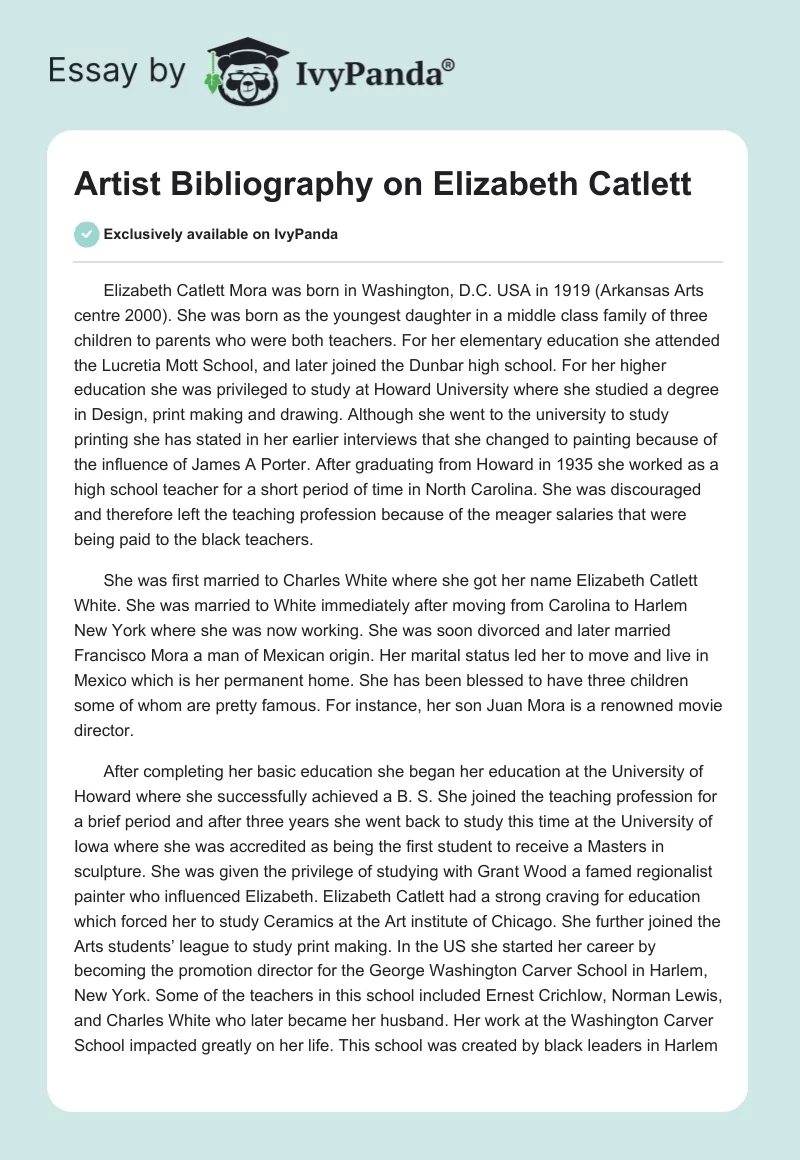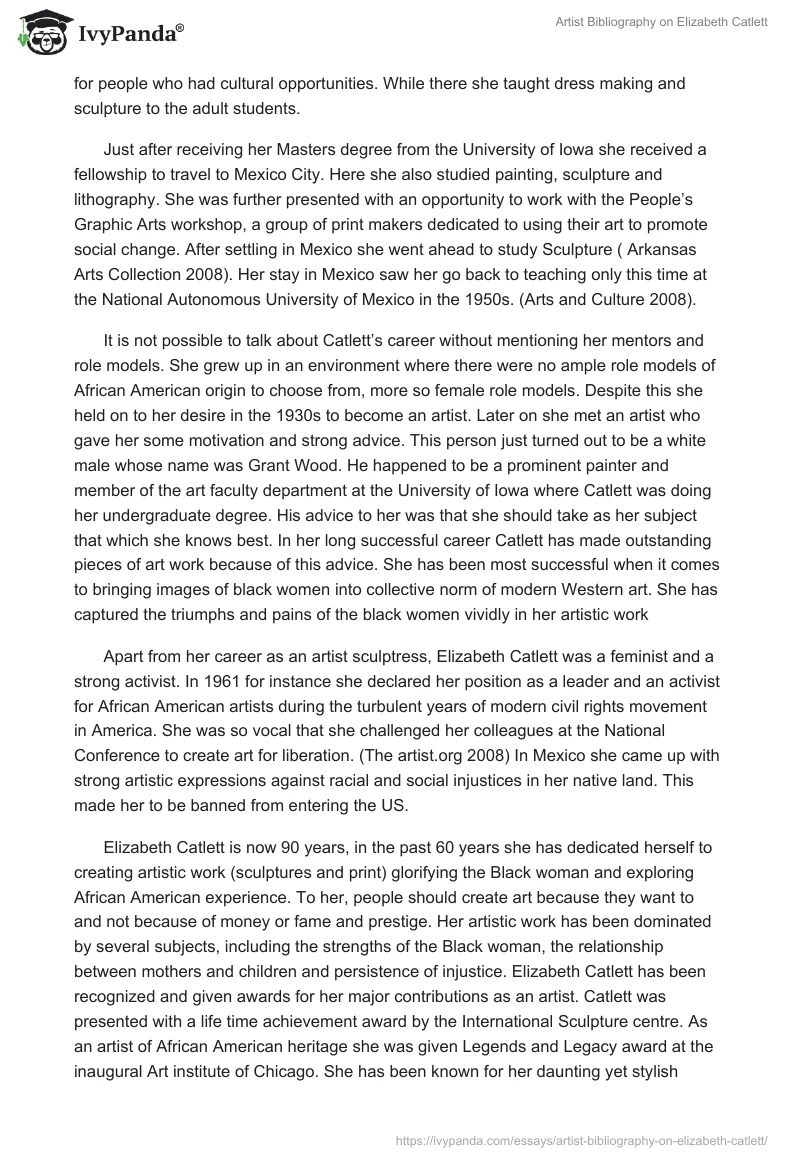Elizabeth Catlett Mora was born in Washington, D.C. USA in 1919 (Arkansas Arts centre 2000). She was born as the youngest daughter in a middle class family of three children to parents who were both teachers. For her elementary education she attended the Lucretia Mott School, and later joined the Dunbar high school. For her higher education she was privileged to study at Howard University where she studied a degree in Design, print making and drawing. Although she went to the university to study printing she has stated in her earlier interviews that she changed to painting because of the influence of James A Porter. After graduating from Howard in 1935 she worked as a high school teacher for a short period of time in North Carolina. She was discouraged and therefore left the teaching profession because of the meager salaries that were being paid to the black teachers.
She was first married to Charles White where she got her name Elizabeth Catlett White. She was married to White immediately after moving from Carolina to Harlem New York where she was now working. She was soon divorced and later married Francisco Mora a man of Mexican origin. Her marital status led her to move and live in Mexico which is her permanent home. She has been blessed to have three children some of whom are pretty famous. For instance, her son Juan Mora is a renowned movie director.
After completing her basic education she began her education at the University of Howard where she successfully achieved a B. S. She joined the teaching profession for a brief period and after three years she went back to study this time at the University of Iowa where she was accredited as being the first student to receive a Masters in sculpture. She was given the privilege of studying with Grant Wood a famed regionalist painter who influenced Elizabeth. Elizabeth Catlett had a strong craving for education which forced her to study Ceramics at the Art institute of Chicago. She further joined the Arts students’ league to study print making. In the US she started her career by becoming the promotion director for the George Washington Carver School in Harlem, New York. Some of the teachers in this school included Ernest Crichlow, Norman Lewis, and Charles White who later became her husband. Her work at the Washington Carver School impacted greatly on her life. This school was created by black leaders in Harlem for people who had cultural opportunities. While there she taught dress making and sculpture to the adult students.
Just after receiving her Masters degree from the University of Iowa she received a fellowship to travel to Mexico City. Here she also studied painting, sculpture and lithography. She was further presented with an opportunity to work with the People’s Graphic Arts workshop, a group of print makers dedicated to using their art to promote social change. After settling in Mexico she went ahead to study Sculpture ( Arkansas Arts Collection 2008). Her stay in Mexico saw her go back to teaching only this time at the National Autonomous University of Mexico in the 1950s. (Arts and Culture 2008).
It is not possible to talk about Catlett’s career without mentioning her mentors and role models. She grew up in an environment where there were no ample role models of African American origin to choose from, more so female role models. Despite this she held on to her desire in the 1930s to become an artist. Later on she met an artist who gave her some motivation and strong advice. This person just turned out to be a white male whose name was Grant Wood. He happened to be a prominent painter and member of the art faculty department at the University of Iowa where Catlett was doing her undergraduate degree. His advice to her was that she should take as her subject that which she knows best. In her long successful career Catlett has made outstanding pieces of art work because of this advice. She has been most successful when it comes to bringing images of black women into collective norm of modern Western art. She has captured the triumphs and pains of the black women vividly in her artistic work
Apart from her career as an artist sculptress, Elizabeth Catlett was a feminist and a strong activist. In 1961 for instance she declared her position as a leader and an activist for African American artists during the turbulent years of modern civil rights movement in America. She was so vocal that she challenged her colleagues at the National Conference to create art for liberation. (The artist.org 2008) In Mexico she came up with strong artistic expressions against racial and social injustices in her native land. This made her to be banned from entering the US.
Elizabeth Catlett is now 90 years, in the past 60 years she has dedicated herself to creating artistic work (sculptures and print) glorifying the Black woman and exploring African American experience. To her, people should create art because they want to and not because of money or fame and prestige. Her artistic work has been dominated by several subjects, including the strengths of the Black woman, the relationship between mothers and children and persistence of injustice. Elizabeth Catlett has been recognized and given awards for her major contributions as an artist. Catlett was presented with a life time achievement award by the International Sculpture centre. As an artist of African American heritage she was given Legends and Legacy award at the inaugural Art institute of Chicago. She has been known for her daunting yet stylish sculptures that display case the female form, sometimes with a child. In relation to this sculpture she says that she likes the challenge presented by the technical problem, the relationship between the two figures. To her this is an emotional thing since she is a mother. (Ebony, March, 2006 by Lynn Norment). Materials that compose her sculpture ranges from Cedar, mahogany, eucalyptus, marble, limestone, onyx, bronze to Mexican stone. From these materials we get a resulting figure that is without fail dramatic and graceful. Other carvings that she has created include Dancing figure which she did in 1961, The Singing Head, The Black Woman Speaks and Target (1970).In print she has been successful just as she is in carving. Some of her well known prints are Sharecropper (1970), and MalcomX speaks for us (1969), Survivor (1983) which was a linocut of a strong Black woman that she printed in Mexico. Her efforts have been channeled greatly towards creating public art. For instance in New York stands her tribute to writer Ralph Ellison, which is a big rectangle with hole in the middle. She is of the opinion that public art should have meaning to Black people and which African Americans can identify with. She affirms that the purpose of o her work is to present black people in their beauty and dignity for both Blacks and other people of a different race to understand and to take pleasure in her exhibitions( Elizabeth Catlett: Prints and Sculptures 2002_2003). In addition she has created plentiful of other outdoor sculptures of which some are displayed in Mexico, Mississippi, New Orleans, LA and Washington D.C.
Most of Elizabeth Catlett’s works when in America were done during the chaotic times of the civil rights movement. These were indeed turbulent times. There were many cases of political assassinations and it was during this time that Martin Luther King was killed. The struggle for equal rights created a platform for visual artists to shift their conception and start creating art for social and political expression. Elizabeth Catlett was not left behind for she created art that presented the suffering of the Black people. This was a major challenge to her as she was banned from entering the US because of her artistic work with strong political expressions. Even though she did not live in the US, in her adult life she continued her work with the expression in Mexico.
References
- African American. Arts and Culture: Art Focus.
- Arkansas Arts Centre. The Collection. Drawing Collection. Elizabeth Catlett. 2000.
- Briefings. The University Record. 1998. Web.
- High Beam Encyclopedia. Elizabeth Catlett. 2008. Web.
- Lynn Norment. BusinessNet Elizabeth Catlett: legendary artist is still creating and living life on her own terms. 2006.
- Nancy Andreasen. Andreasen Book Reviewed (Wall Street Journal) 2005.
- The Cleveland Museum of Art.
- Wikipedia. Elizabeth Catlett.


